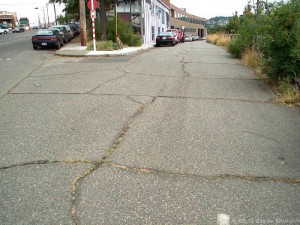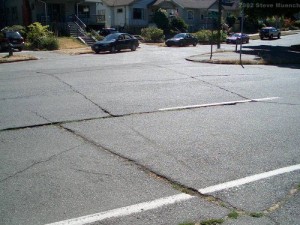Joint Reflection Cracking
Cracks in a flexible overlay of a rigid pavement. The cracks occur directly over the underlying rigid pavement joints. Joint reflection cracking does not include reflection cracks that occur away from an underlying joint or from any other type of base (e.g., cement or lime stabilized).

Joint reflective cracking on a low-use industrial road. This pavement has been cracked for many years and will probably not get much worse. Notice the grass growing in the cracks.

Joint reflective cracking on an urban arterial. Some joint reflective cracks on this pavement are crack sealed but these are probably too advanced and too wide to be crack sealed.
Problem
Allows moisture infiltration, roughness
Possible Causes
Movement of the rigid pavement slab beneath the HMA surface because of thermal and moisture changes. Generally not load initiated, however loading can hasten deterioration.
Repair
Strategies depend upon the severity and extent of the cracking:
- Low severity cracks (< 1/2 inch wide and infrequent cracks). Crack seal to prevent (1) entry of moisture into the subgrade through the cracks and (2) further raveling of the crack edges. In general, rigid pavement joints will eventually reflect through an HMA overlay without proper surface preparation.
- High severity cracks (> 1/2 inch wide and numerous cracks). Remove and replace the cracked pavement layer with an overlay.
Surface Distresses



